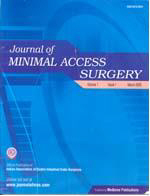
|
Journal of Minimal Access Surgery
Medknow Publications
ISSN: 0972-9941 EISSN: 1998-3921
Vol. 3, Num. 4, 2007, pp. 121-122
|
Journal of Minimal Access Surgery, Vol. 3, No. 4, October-December, 2007, pp. 121-122
Editorial
Thoracoscopic surgery
Bhanushali HS
Department of Surgery, Kaushalya Medical Foundation Trust Hospital, Behind Nitin Co Ganeshwadi Panchpakhadi, Thane (West), Thane - 400 601
Correspondence Address:Department of Surgery, Kaushalya Medical Foundation
Trust Hospital, Behind Nitin Co. Ganeshwadi Panchpakhadi, Thane (West), Thane
- 400 601, hsbhanushali@yahoo.com
Code Number: ma07028
"Mine is yesterday, I know tomorrow."
Tibetan book of BC 3500
I
am grateful to the editorial board of Journal of Minimal Access Surgery
for requesting me to be the Guest Editor for this special issue on Thoracoscopy.
Never did I think that that thoracoscopy will reach such an eminence
and level of acceptance worldwide. It is a tribute to surgeons who are
involved in performing minimal access surgery who have taken to thoracoscopic
technique all over the world, since minimal invasive surgery was started
since 1991. We started doing thoracoscopy in 1991.
Thousands of thoracoscopic procedures were performed for the division
of pleural adhesions between 1910, (the year the technique was instituted
by the Swedish internist Hans Jacobeus) and 1955 (when the technique
became obsolete following discovery of anti tuberculous drugs). Thoracoscopy
was carried out only under local anesthesia using only primitive instruments
and lighting.
Why is it that after several decades of infrequent use thoracoscopic
procedures are again gaining importance throughout the world? The use
of thoracoscopy
has been resumed partly as a result of considerable progress in modern
techniques, particularly in the following two areas: 1) Endoscopic instrumentation
has been greatly improved; telescopes now have an extremely high optical
quality in spite of their very small diameter and 2) Progress in anesthesia
has allowed for a wide choice ranging from local anesthesia for outpatients
to general anesthesia with endotracheal intubation (single lung anaesthesia).
Jacobeus himself believed that thoracoscopy could be used not only to divide
pleural adhesions but also perform pleural biopsies for histopathology
and early diagnosis of pleural pathology - the commonest one in his times
being tuberculosis. In addition to visualization of pleural surfaces, the
lung itself can be examined from various angles. In spontaneous pneumothorax
minute emphysematous bullous lesions and blebs less than 5 mm in diameter
are seen nearly in all patients when the lungs are examined using a high
resolution video camera and xenon light. It can therefore be said that
no patient with spontaneous pneumothorax has a "normal lung". The information
obtained by thoracoscopy in these patients is superior to that derived
by high resolution CT scanning or any other investigative modality short
of open thoracotomy.
The entire thoracic cavity is accessible to video assisted thoracoscopy
permitting diagnosis of peripheral pulmonary lesions - whether diffuse
or localized nodules, chronic empyema and also benign or malignant pathology.
Thoracoscopy can easily replace many diagnostic and therapeutic procedures
hitherto carried out by open surgery involving a thoracotomy. It is possible
to carry out biopsies from diaphragmatic surfaces, pericardium, mediastinal
nodes or masses. Sectioning of sympathetic nerves (sympathectomy) can
be used for vasomotor syndromes affecting the upper limb. Drainage of
empyema,
decortication of stage II empyema, coagulation of blebs and excision
of bullae in pneumothorax as well as advanced procedures such as esophageal
mobilization and resection can be performed by a surgeon accomplished
at
thoracoscopic surgery.
Thoracoscopy, while allowing full exploration of the thoracic cavity
is much less invasive and incapacitating than thoracotomy. Complications
are
uncommon and occur rarely when the procedure is performed by someone
who has mastered the technique. The cost of treatment is much less
than thoracotomy
because of the shorter period of hospitalization; an average of no
more than two to five days. There are no sequelae as long as effective
pleural
drainage ensures complete pleurodesis. No rehabilitation is required
and a normal active life can be resumed within a few days.
Thoracoscopy has not remained the domain of thoracic surgeons but cardiac
surgeons too perform pericardiectomy, coronary artery bypass surgery
using minimal access thoracic techniques. Also orthopedic surgeons
undertake spinal surgeries such as biopsy from spinal lesions, drainage
of spinal
cold abscesses and complex corrective surgeries for scoliosis.
This special issue has two main goals. Firstly, it highlights that
thoracoscopic techniques can be used for myriad of conditions as
seen from the various
articles appearing in this issue. Secondly, the issue also underscores
the point that with adequate training and a thorough understanding
of the basic principles of thoracic surgery, even general surgeons
can perform
basic thoracosocpic procedures. In the hands of accomplished surgeons,
sky seems to be the limit for the use of thoracoscopy in thoracic
pathology.
Copyright 2007 - Journal of Minimal Access Surgery
| 